How Do I Know When I Need a New Roof? (6 Signs It’s Time for One)
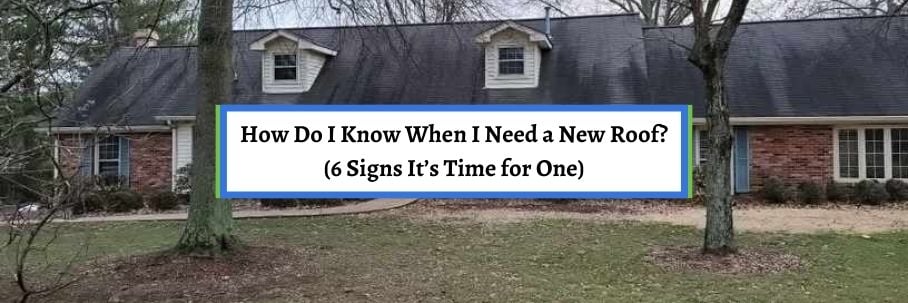
Needing a new roof isn’t something homeowners want to deal with. However, waiting too long for a replacement can lead to costly damage to the interior of your home.
So, whether you have an old roof, want to be proactive, or a roofer said it’s time, you need to know how to determine if you need a new roof.
For over 30 years, Bill Ragan Roofing has provided homeowners with transparent and unbiased roofing knowledge. So, let’s break down the ways to tell if you need a new roof.
In this article, you’ll learn how to identify the six signs that it’s time for a roof replacement.
How do you know you need a new roof?
As long as your roof is properly installed and properly ventilated, you shouldn’t need a new roof until the materials have reached the end of their lifespan. But you won’t know this information unless you know exactly when your roof was installed and/or how long your roofing material lasts.
Luckily, a roof shows signs that tell you it’s time to replace it.
Continuous and frequent roof leaks
Just because a roof leaks doesn’t mean it needs to be replaced, but context is everything. You obviously don’t need a new roof if a leak is caused by something as simple as nail pops or a cracked pipe boot.
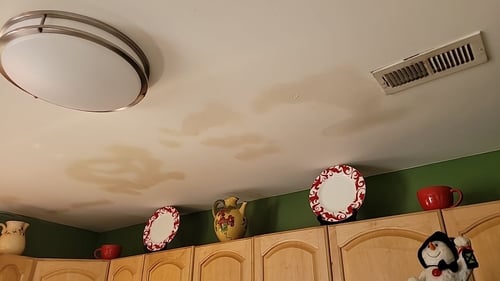
However, experiencing continuous leaks means your roof is improperly installed or has reached its maximum lifespan, and it may be time for a replacement. Some leaks are hard to find and repair, so it’s possible a nagging leak could be from the same problem that takes a couple of tries to fix.
However, you’ll most likely need a new roof if you’re experiencing continuous leaks in multiple areas on an aged roof.
Dark spots on the decking in your attic
Roof decking is the wooden foundation of your entire roof system. If water reaches the decking, it creates serious problems like mildew, mold, and structural damage when the wooden boards rot or break.
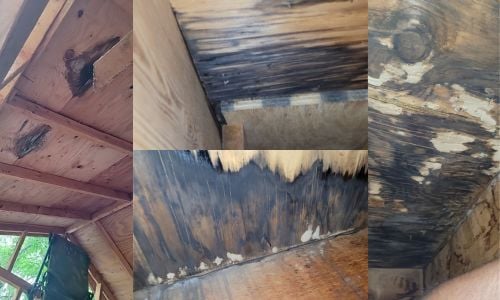
If your decking is rotting and seriously compromised in multiple areas, you need a new roof or, at the very least, extensive and costly repairs. Under normal circumstances, you can’t see the extent of decking problems without tearing off your old roof.
However, you can check the bottom of the decking in your attic for discoloration to see how serious the issue is. If you see dark spots or other discoloration, water is getting underneath your roofing materials and has soaked all the way through the wood.
This means there’s been an active problem for a while, and you’ll definitely need a new roof if there are multiple areas of rotting boards.
Lifted, cracked, and curled shingles
As a roof reaches the end of its lifespan, the materials fail and even deteriorate. A clear sign that you need a new roof is seeing lifted, curling, and/or cracked shingles.
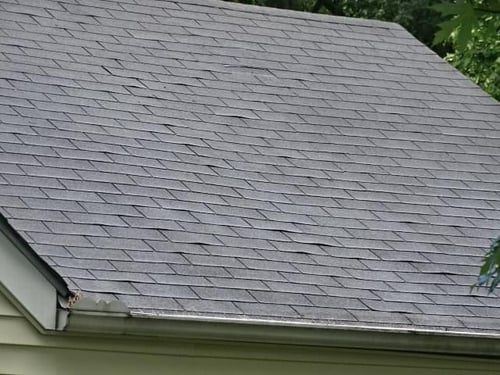
Once the shingles reach this point, there’s nothing left to do but replace them. It’s possible to spot this sign from the ground if it’s extensive, but it usually requires getting on a ladder or the roof.
If you don’t have ladder experience or feel 100% confident on one, I don’t recommend risking your safety. If anything, use your phone or another camera to zoom in on a spot before getting a ladder out.
Loose granules in your gutters or around downspouts
Granules are pieces of asphalt embedded in shingles for fire resistance, color, and UV ray protection. Losing granules is natural as your roof ages from wear and tear.
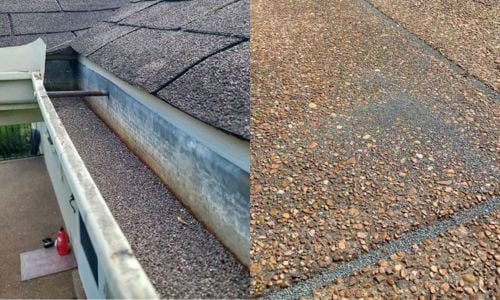
Once you notice loose granules or heavy granular loss, it’s time for a new roof. You’ll notice this sign by finding loose granules in gutters and around downspouts or splash blocks.
.jpg?width=500&height=375&name=GranuleLoss%20(2).jpg)
You can also spot extreme granular loss by looking at your shingles. If it’s bad enough, you’ll see bald spots and discoloration that tell you the shingles have reached the end of their effectiveness.
Vegetation growth on your roof
Seeing vegetation on shingles may seem insignificant, but moss or other vegetation growth is actually a sign that it’s time to start getting ready for a new roof. Now, it could be growing from debris built up, lack of sun hitting a damp roof, overhanging trees, etc.
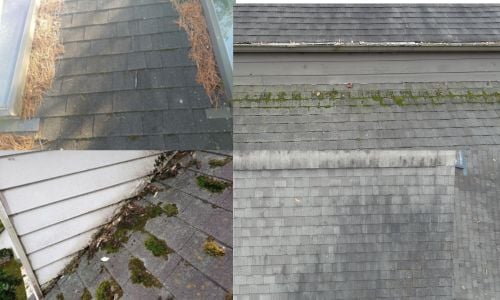
However, vegetation growth is usually a clear sign you have an older roof. So, while it may not need replacing immediately, it’s time to start thinking about getting a new roof.
You’ll also probably see black algae streaks on a 10 to 15-year-old roof, but this doesn’t necessarily mean you need a new roof. It’s more of an aesthetic issue that can be cleaned off if the look bothers you.
Just make sure you hire a professional roof cleaning company that knows how to soft wash to avoid knocking granules loose and shortening the lifespan of the shingles.
Roof damage caused by storms
The signs we’ve already covered are usually caused by improper installation or an aged roof. However, a huge sign that you need a new roof is when it’s damaged by hail or wind during storms.
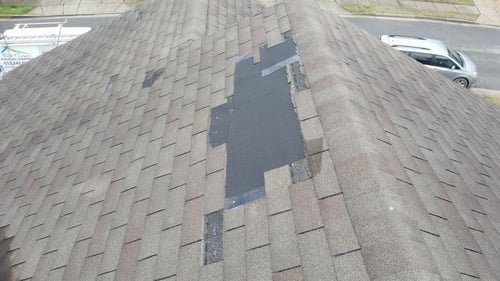
Wind damage is easy to spot because there will be missing shingles or whole roof sections, which leaves your roof decking exposed. In extreme circumstances, you could even have a tree or tree limbs fall on your roof from strong winds.
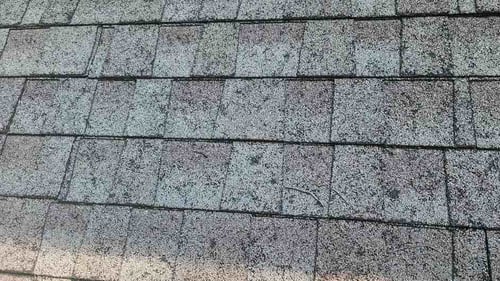
While wind damage is noticeable, hail damage is a little tougher to spot with an untrained eye. Hail (around 1” in diameter) will damage shingles by leaving dents and bruises that require experience and being on the roof to spot.
But remember, I don’t recommend risking your safety if you’re not 100% confident on a ladder.
Instead, you should look for collateral hail damage to other things around your property like:
- Dents on gutters and downspouts above 5’
- Dents or strikes on your garage door
- Holes in your window screens
- Dings to any painted wood or shutters
- Splatter marks or dings to your electric meter, AC unit, or grill
- Dents to your mailbox and other soft metals on your property
If your roof has any of the above storm damage, you’ll most likely need a new roof. Luckily, your homeowners insurance will pay (depending on the policy) for most or all of your new roof if it was damaged by extreme weather.
7 things to consider before getting a new roof
Now, you know the signs that tell you it’s time for a new roof. If you notice any of the signs discussed here, there’s a good chance you need a new roof.
However, you won't truly know until after a roof inspection. If you’re here, though, you probably think it’s time for a roof replacement.
But before jumping into the roof replacement process, there are some things you need to consider when getting a new roof. There are even things you need to know before scheduling an inspection with a roofer.
That’s why I wrote another article breaking down what every homeowner must consider when going through the replacement process.
Check out 7 Things to Consider Before a Roof Replacement to learn what you need to know about getting a new roof.


